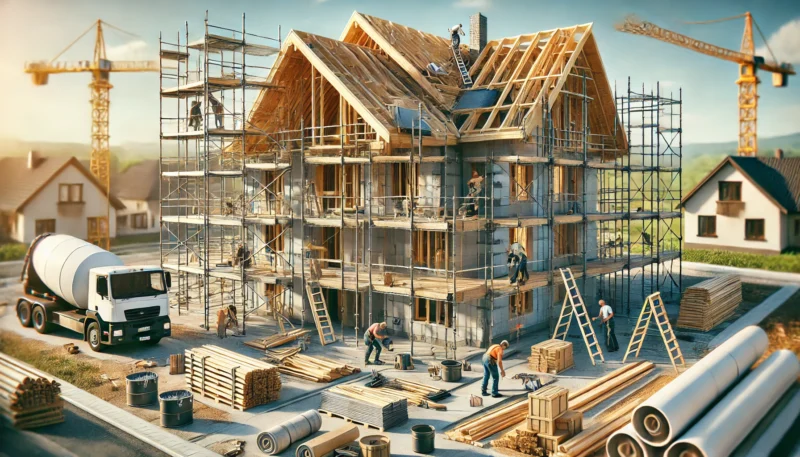Are you looking at buying your first home in Australia in 2024? It can be exciting, terrifying, daunting, frustrating, and expensive – all at the same time! Property markets are strengthening by the day, with prices in most states close to or surpassing their COVID-19 pandemic peaks.
While the strengthening market and climbing property prices are good news for many, stepping onto the property ladder for the first time is getting further out of reach for some buyers. The Reserve Bank’s 13 interest rate hikes, sluggish wage growth, and higher deposits are just some of many factors that have put many buyers on the back foot.
But to help, federal and state governments have implemented a whole suite of schemes, incentives, and fee waivers to help eligible Aussies realise their home-ownership dream faster. Here’s a rundown of everything available, including eligibility requirements.

1. The Home Guarantee Scheme (HGS)
The HGS is a federal government initiative put in place to help Aussies buy or build their first home. Split into three categories depending on eligibility, first-home buyers can get assistance for buying a home and get onto the property ladder faster with as little as a 2% deposit without the need to buy lenders mortgage insurance (LMI).
Under the HGS, home buyers can buy a residential property including:
- An existing house, townhouse, or apartment
- A house and land package
- Land and a separate contract to build a home
- An off-the-plan apartment or townhouse

Note: Each home guarantee scheme is eligible only for applicants who meet the criteria and who are looking to purchase an eligible property within the price cap - the price cap is the same for each new home buyer scheme.
Price Cap by Region
| State | Capital City and Regional Centre* | Rest Of State |
|---|---|---|
| NSW | $900,000 | $750,000 |
| VIC | $800,000 | $650,000 |
| QLD | $700,000 | $550,000 |
| WA | $600,000 | $450,000 |
| SA | $600,000 | $450,000 |
| TAS | $600,000 | $450,000 |
| ACT | $750,000 | |
| NT Regional | $600,000 | |
| Jervis Bay Territory & Norfolk Island | $550,000 | |
| Christmas Island and Cocos (Keeling) Islands | $400,000 | |
Source: Housing Australia
2. First Home Guarantee (FHBG)
The FHGB home buying scheme has 35,000 places per financial year, giving first-home buyers the chance to buy a new or existing eligible property with a deposit as low as 5% while avoiding LMI. The new home buyer scheme can’t be used to buy an investment property.
To be eligible for the First Home Guarantee, applicants must comply with the following criteria:
- Be first home buyers or have not owned a property for the past 10 years
- Earn less than $125,000 for singles or $200,000 for couples
- Couples can be married, de facto, friends, siblings, or groups of family members
- Aged 18+
- Australian citizens or permanent residents
- Have a deposit of 5-20%
- Buy a home within the corresponding price cap
3. Regional First Home Buyer Guarantee (RFHBG)
The federal government issued 10,000 places to regional buyers under its RFHBG scheme to 30 June 2025. First-home buyers can buy their first home in a designated regional area with as little as a 5% deposit without LMI. This new home buyer scheme can’t be used to buy an investment property.
To be eligible for the Regional First Home Buyer Guarantee, applicants must comply with the following criteria:
- Have lived in or adjacent to a regional area for the past 12 months
- Be first home buyers or have not owned a property in the past 10 years
- Earn less than $125,000 for singles or $200,000 for couples
- Couples can be married, de facto, friends, siblings, or groups of family members
- Aged 18+
- Australian citizens or permanent residents
- Have a deposit of 5-20%
- Buy a home within the corresponding price cap

4. Family Home Guarantee (FHG)
The FHG offers home buyers assistance specifically for single parents with at least one dependent child, whether they have previously owned a home or not. Under the FHG, up to 18% of an eligible home buyer’s home loan is guaranteed by the National Housing Finance and Investment Corporation (NHFIC), allowing buyers to purchase a property with as little as 2% without paying LMI. There are 5,000 places available each financial year.
To be eligible for the Family Home Guarantee, applicants must comply with the following criteria:
- An individual with at least one dependent child, including those who are the single legal guardian of a child
- Aged 18+
- Australian citizens or permanent residents
- Earn less than $125,000
- No current property ownership or no ownership in the past 10 years
- Have a deposit of 2-20%
- Buy an eligible home within the corresponding price cap
5. Help-to-buy Scheme
In November 2023, the federal government introduced legislation into the Commonwealth Parliament to establish the Help to Buy Program, which will be administered by Housing Australia.

Note: The program has not yet commenced.
The consultation closed on 21 May 2024, and the Department of Treasury is now taking feedback from stakeholders on the draft Program Directions and Explanatory Statement, which details how the Help to Buy Program will operate.
Under the proposed scheme, the government would assist people earning less than $90,000 a year ($120,000 for couples) to purchase a property by contributing up to 30% of the purchase price for existing properties and up to 40% for new builds. This means buyers can purchase a property with as little as a 2% deposit. Price caps would be consistent with those set for the First Home Guarantee, Family Home Guarantee, and Regional First Home Buyer Guarantee.
The proposed Help-to-buy scheme includes the following criteria:
- Be an Australian citizen aged 18+
- Earn less than $90,000 per year for singles or under $120,000 for couples
- Be a first home buyer with no property owned either in Australia or overseas
- Have a minimum 2% deposit

6. First Home Super Saver Scheme (FHSS)
The First Home Super Saver (FHSS) scheme allows first-home buyers to use some of their eligible voluntary superannuation contributions to help buy their first home. The scheme allows buyers to make voluntary contributions (both before-tax concessional and after-tax non-concessional) into their superfund as a way of saving for a property deposit. It’s important to note that only voluntary contributions are eligible to be used for the scheme; buyers cannot withdraw employer, government, or spouse contributions.
All contributions to super will count towards the ordinary contribution caps that apply, but there is a cap to how much you’re allowed to withdraw. The maximum contribution and withdrawal amount for the FHSS scheme is $15,000 per financial year or $50,000 in total.
To be eligible to use this home-buying scheme and withdraw from your superannuation, you must comply with the following criteria:
- Be a first-home buyer and not have owned property in Australia before
- Aged 18 years or older
- Have not previously used this home-buying scheme to release money from your superannuation
Changes starting on 15 September 2024 will give scheme users better flexibility around amending and withdrawing requests.
7. First Home Owner Grant
State and territory governments introduced the First Home Owner Grant (FHOG) in 2000 to give first-home buyers assistance in buying a home by offsetting GST. The rules around how it works and who is eligible continually evolve and differ for each state and territory, making it challenging to stay updated.
Local governments may give a one-off grant (around $1,000-15,000) to eligible home buyers at the settlement point of their property purchase. To be eligible for the FHOG, you must comply with the following criteria:
- Be a first-home buyer
- Have not previously received a FHOG
- Be an Australian citizen aged 18+
- Live in the house for at least 6 months after it’s built
- Be buying a house up to your local government’s price cap - between $575,000 and $750,000 depending on the state or territory
8. Stamp Duty Waiver
Some states and territories have introduced a stamp duty waiver or reduction in addition to the First Home Owner Grant.
For example, the NSW government has abolished stamp duty on properties valued under $800,000 and has reduced, on a sliding scale, stamp duty on properties with a sale price up to $1 million.
Stamp duty reductions and exemptions are also available for first-home buyers in Victoria, Queensland, Western Australia, Tasmania, and the Northern Territory.
9. State-specific Government Grants and Schemes
In addition to the federal government schemes for home buyers, there are state-specific home-buying schemes and grants that Aussies can use to help get their foot on the ladder. Here’s a breakdown of the additional home buyer's assistance in each state.
Victoria (VIC)
In addition to all the nationwide government incentives, Victorians can also take advantage of the Victorian Homebuyer Fund (VHF). The home buying scheme is a shared equity scheme to help Victorians with a minimum 5% deposit get onto the property ladder quicker. The Victorian government may contribute up to 25% of the purchase price in exchange for an equivalent share in the property, reducing mortgage costs.
To apply for the VHF, you’ll need to meet the following criteria:
- Be an Australian or New Zealand citizen or Australian permanent resident aged 18+
- Have a minimum 5% deposit saved (or 3.5% for Aboriginal and Torres Strait Islander participants)
- Earn under $130,485 for singles or under $216,245 for couples
Victorian first-home buyers can also benefit from stamp duty concessions under the First Home Buyer Duty Reduction. The concession applies on a sliding scale, with an exemption for properties priced up to $950,000 in Melbourne and Geelong and up to $700,000 in regional Victoria.
New South Wales (NSW)
The NSW government has abolished stamp duty on properties valued under $800,000 and has reduced, on a sliding scale, stamp duty on properties with a sale price up to $1 million.

Note: To be eligible, you need to be an Australian citizen or permanent resident aged 18+ buying your first home.
Queensland (QLD)
Buyers in Queensland can take advantage of transfer duty concessions under the Home Concession or First Home Concession schemes.
In some cases, you may not have to pay any duty because the benefit of the concession is equal to or greater than the duty you would otherwise pay. This will depend on the value of the property you are buying.
For example, you will not pay any transfer duty if you are eligible to claim a first home concession and the value of the home is $700,000 and under.
Queenslanders with a household income under $141,000 who can afford to buy but can’t get private finance can use the Queensland housing finance loan to help secure a property with just a 2% deposit and no LMI.
Australian Capital Territory (ACT)
The ACT government offers home buyers its Home Buyer Concession Scheme to reduce or remove stamp duty costs.

Note: Buyers need to be aged 18+ and live in the new property for a year after settlement.
Depending on the number of children the buyer has, there is a sliding scale of income thresholds, and they can get a concession of up to $34,504 on the stamp duty payable on the property at purchase.
Northern Territory (NT)
Buyers in the NT can access the nationwide home buyer incentives listed above.
Those looking to buy a house and land package in the NT may be eligible for a stamp duty exemption under the House and Land Package Exemption (HLPE).
This means the buyer does not pay any stamp duty, regardless of the value of the property or the building contract.

Note: To be eligible, the buyer must buy a house and land package from a building contractor in a single transaction and sign the contract between 1 July 2022 and 30 June 2027.
South Australia (SA)
In addition to all the nationwide government incentives, buyers in South Australia can also take advantage of the government’s HomeStart initiative.
The scheme allows South Australians with a deposit under 20% to avoid paying LMI by offering a secondary loan to cover the costs associated with buying a house, such as stamp duty.

Note: To be eligible for a HomeStart loan, buyers must have a net household income under $75,000 for singles and $100,000 for couples, not own another property, and have enough funds to cover the deposit but not the remaining upfront costs like Stamp Duty.
Tasmania (TAS)
In Tasmania, buyers can receive a total stamp duty reduction (100%) for purchases under $750,000. The policy is retrospective to February 18, 2024.

Note: To be eligible, buyers must be at least 18 years of age, Australian citizens or permanent residents, must not have previously owned a home in Australia, and must not have received a First Home Owner Grant or the Duty Concession before in any state.
Can You Apply for Multiple Government Grants and Schemes?
In some cases, you can apply for multiple government grants and schemes if you’re eligible for them.
For example, a first-home buyer can apply for a First Home Guarantee or a First Home Owners Grant and also waive or reduce their stamp duty, depending on their income, location, and property price points.
However, you cannot apply for the same concession twice, and in some cases, concessions are only available for buyers who have not received another type of government home buyer support.
What Are the Drawbacks of Government Schemes?
While numerous home-buying schemes provide assistance for buying a home, there are a few cons to using them.
For example:
- Despite increased caps, they're still lower than average prices in many areas.
- Small volumes of properties are eligible for stamp duty waivers in desirable locations.
- It encourages people to get into debt, especially for those who may struggle to keep up with loan repayments.
- Higher monthly repayments due to a smaller downpayment.
- Schemes may put upward pressure on the lower end of the property market.
- Buyers who purchase with a very small deposit risk falling into negative equity.
- Mortgage holders may face bankruptcy amid surprisingly fast rate rises.
- Borrowers with low equity will be stuck in their property for longer than planned.
- Incentives aren’t available to investors.

Note: With high prices, dwindling borrowing power, and soaring interest rates, stepping onto the property ladder for the first time is slipping further out of reach for many Aussies.
While there are options for first-time buyers to purchase a property without the added pressure of saving a huge 20% deposit, there are plenty of risks involved.

Tip: Before going down the route of one of the many available government schemes, make sure to speak to an expert to ensure your potential property purchase makes good long-term investment sense.














